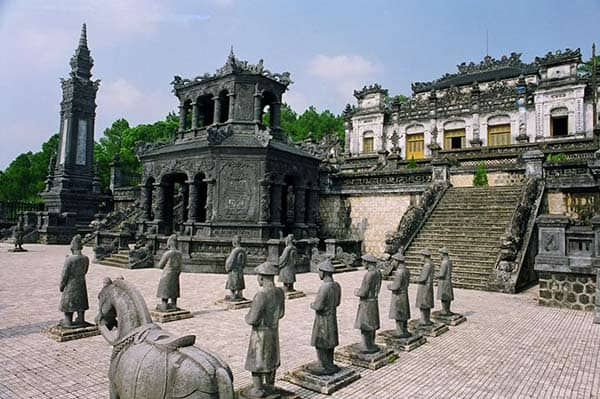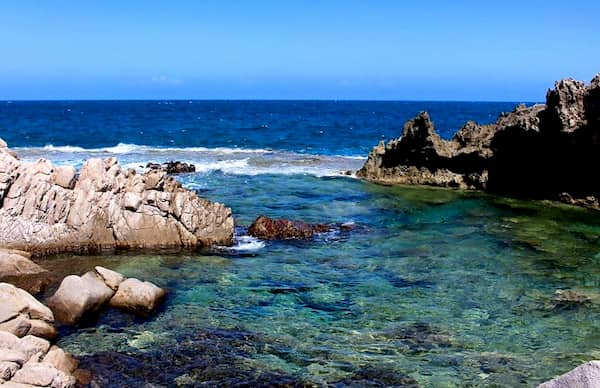CENTRAL VIETNAM
HISTORY AND MAIN DESTINATIONS
Central Vietnam is a region that hosts popular destinations for some, while others are still not very popular. However, the region's assets are numerous and diversified. Whether you are interested in historical and cultural sites, beautiful beaches or fabulous local cuisine, you will certainly find your happiness in Central Vietnam.
History of Central Vietnam
It is impossible to talk about the history of Central Vietnam without talking about the kingdom of Champa. This kingdom flourished over several periods spread between the 2nd and 19th centuries. Information on the kingdom of Champa is quite limited, although researchers have recently made important discoveries that have led to a better understanding of the history of this kingdom.
It would seem that the first Chams (the inhabitants of the kingdom of Champa) have their origins in settlers dating from the late Neolithic period and that they arrived in central Vietnam as we know it today by sea, from various Indonesian islands. Their main activities were thus linked to the sea: trade, piracy, transport, etc. They had many important ports which were the starting point for several major trade routes, linking the territory with the Indonesian islands, China and India. The kingdom was made up of several constituencies.
The kingdom of Champa was at the origin of Hindu culture. The people then largely converted to Islam, following contact with Arab, Indian and Persian merchants from the 11th century onwards. The Cham language belongs to the Malayo-Polynesian group and is therefore part of the Austronesian language family. This language group was based on Sanskrit, the language of Hindu scientific, literary or religious texts. Finally, the Cham culture was very much focused on music, song and dance. Through these activities, we found elements of the daily life of the population. These folk dances are still present today in several art festivals.

The tomb of King Khai Dinh
The main destinations in Central Vietnam
Hoi An
">
Hoi An is one of the leading destinations in Central Vietnam but also in the country in general. The city has many assets that explain its popularity with tourists. First of all, it is a very lively place but at the same time enjoying a peaceful and relaxing atmosphere. In Hoi An you will enjoy an exceptional culture and gastronomy, while admiring the architecture of the shops and old houses. It is also a fairly old destination.
Hoi An is one of the leading destinations in Central Vietnam but also in the country in general. The city has many assets that explain its popularity with tourists. First of all, it is a very lively place but at the same time enjoying a peaceful and relaxing atmosphere. In Hoi An you will enjoy an exceptional culture and gastronomy, while admiring the architecture of the shops and old houses. It is also a fairly old destination.
The old town of Hoi An was listed as a UNESCO World Heritage Site in 1999. The streets of the old city are beautiful and you can get lost for hours without ever getting tired of it. In some streets you can feel the French influence through the architecture of many buildings, while others will offer you the opportunity to visit old houses or museums, while the many restaurants offering excellent local specialities will make your stay in Hoi An unforgettable. In addition, thousands of multicoloured lanterns and different shapes are present and make the setting splendid and unique, even more so in the evening when the old town takes on a completely different shape and reveals its irresistible charm. These lanterns represent one of the most important and iconic symbols of the city.
The Japanese bridge is another symbol of the city and is undeniably a must when you visit Hoi An. It would be unthinkable not to visit this bridge with its architecture marked by Japanese and Chinese influences. Today, it is a meeting place for the locals, which offers a memorable spectacle for visitors, but also a sacred place in the city.
The My Son sanctuary, classified by UNESCO, is a temple that was built by the Cham between the 4th and 12th centuries. This is a very interesting visit for those who wish to learn more about the history of the Kingdom of Champa and the history of Vietnam in general. Many ruins stretching over nearly 2km will attract your attention and you will have an idea of what the temples of this kingdom might look like.
Cam Kim Island, accessible from Hoi An via a bridge, preserves its authenticity and charm today because few tourists visit the island. Instead of tourists, you will rather meet on the spot craftsmen of round boat manufacturers, mat weavers, wood carvers,…To go for a bike ride around this island is a magical and very soothing moment, far from the hustle and bustle of the heart of the city, which is only a few hundred meters away. You will find yourself in the middle of rice fields but also farmers and fishermen who will not hesitate to greet you and smile at you, which will make this moment even more memorable.
The village of Tra Que is an agricultural village that does not use any GMOs or machines. Everything is cultivated using ancestral tools and techniques. In this village not far from Hoi An, you will be able to enjoy an imperturbable calm, the kindness of the locals, a cooking class and why not participate in agricultural activities if you feel like it. You will then realize that handling tools such as the typical double-watering can is not an easy thing.
Hue
Another must-see destination in central Vietnam, Hue is an extremely important city both culturally and historically. Indeed, Hue is a former imperial capital of Vietnam (it was from 1802 to 1945). The influence of the imperial presence can still be felt today in Hué, whether in art, architecture, gastronomy,..
Hué is a real jewel for lovers of culture in all its forms, a set of monuments of the city was listed as a UNESCO World Heritage Site in 1993.
Among this complex is the Royal Citadel, a 10km-long enclosure housing the Imperial City and the Forbidden Purple City, two very important sites at the time when the city was the country's imperial capital.
You can also visit the tombs and mausoleums of several Nguyen kings. Each tomb is different in terms of architecture, size and decoration. However, they are all very beautiful and represent interesting visits.
The gastronomy of Hué will also seduce you. Indeed, we often refer to the "apogee of Vietnamese gastronomy" when we talk about the city's gastronomy. Royal cuisine, popular cuisine and vegetarian cuisine, the dishes you will taste in Hué will impress you both by their presentation and their flavour.

The sea in Central Vietnam
Nha Trang is a seaside resort whose bay is part of the Club of the most beautiful bays in the world. The city was founded in 240 and was once part of the kingdom of Champa. In Nha Trang, we can visit the remains of this kingdom and this civilization.
The Cham Po Nagar Towers represent the main remains that can still be visited today. The place is very popular with tourists but also with locals who go there as a place of worship.
The beaches of Nha Trang are mostly magnificent and allow you to practice various nautical activities, such as scuba diving (in the bay of Nha Trang and the bay of Van Phong which is quite close, these two bays allowing you to observe a very varied fauna), surfing, parachuting, sailing,...
The Nha Trang Oceanographic Institute, founded in 1922, works for the research and preservation of marine ecology while exhibiting on two floors various marine species, whale skeletons, dedicated tools used for fishing,...
All this combined with a favourable geographical location and an ideal climate make Nha Trang one of the most popular seaside resorts in Central Vietnam, and even in the whole country.
Danang is one of the 5 largest cities in Vietnam. There are both skyscrapers and a coastline of more than 30 km.
Da Nang has some of the most beautiful beaches in the country, as does the Non Nuoc beach, which is even considered one of the most beautiful in the world. These beaches offer a variety of water sports and local fish-based specialities from central Vietnam.
The Cham Art Museum provides an opportunity to learn more about the culture and daily life of the Cham, with a large collection of antiques.
The golden bridge, inaugurated in 2018, is a new tourist attraction of the destination, offering a beautiful view of the surrounding hills. The architecture of the bridge is also an asset in itself that encourages visitors to visit it. Indeed, the bridge, 150 m long and located at an altitude of 1,400 m, is held in the air by two giant hands.
The Centre of Vietnam is therefore an ideal destination for lovers of culture and history but also for lovers of beaches, relaxation and water sports. The region has very different destinations but all have undeniable assets. The Centre of Vietnam is therefore very popular with tourists, while hosting several extremely interesting regions that are still protected from mass tourism.



